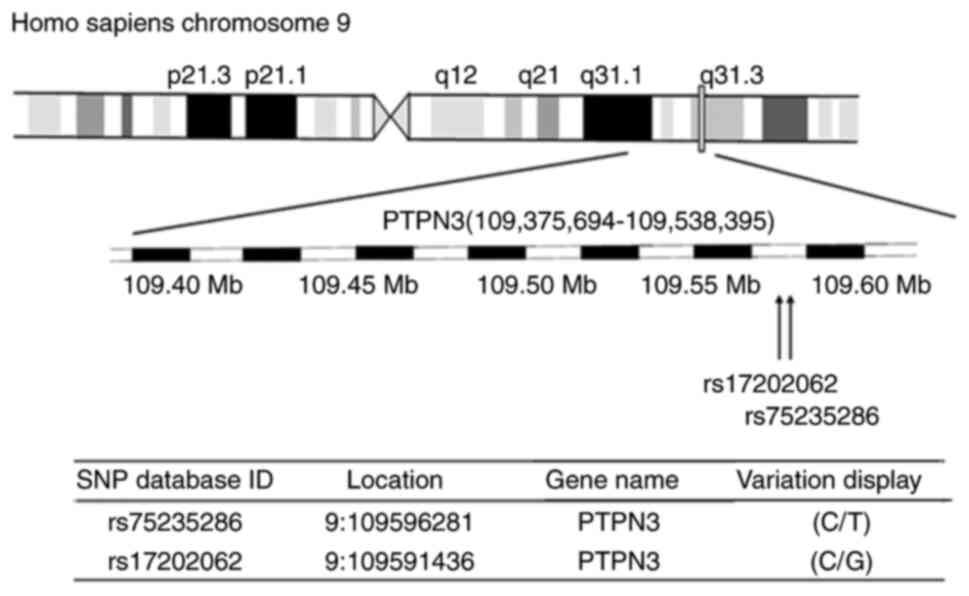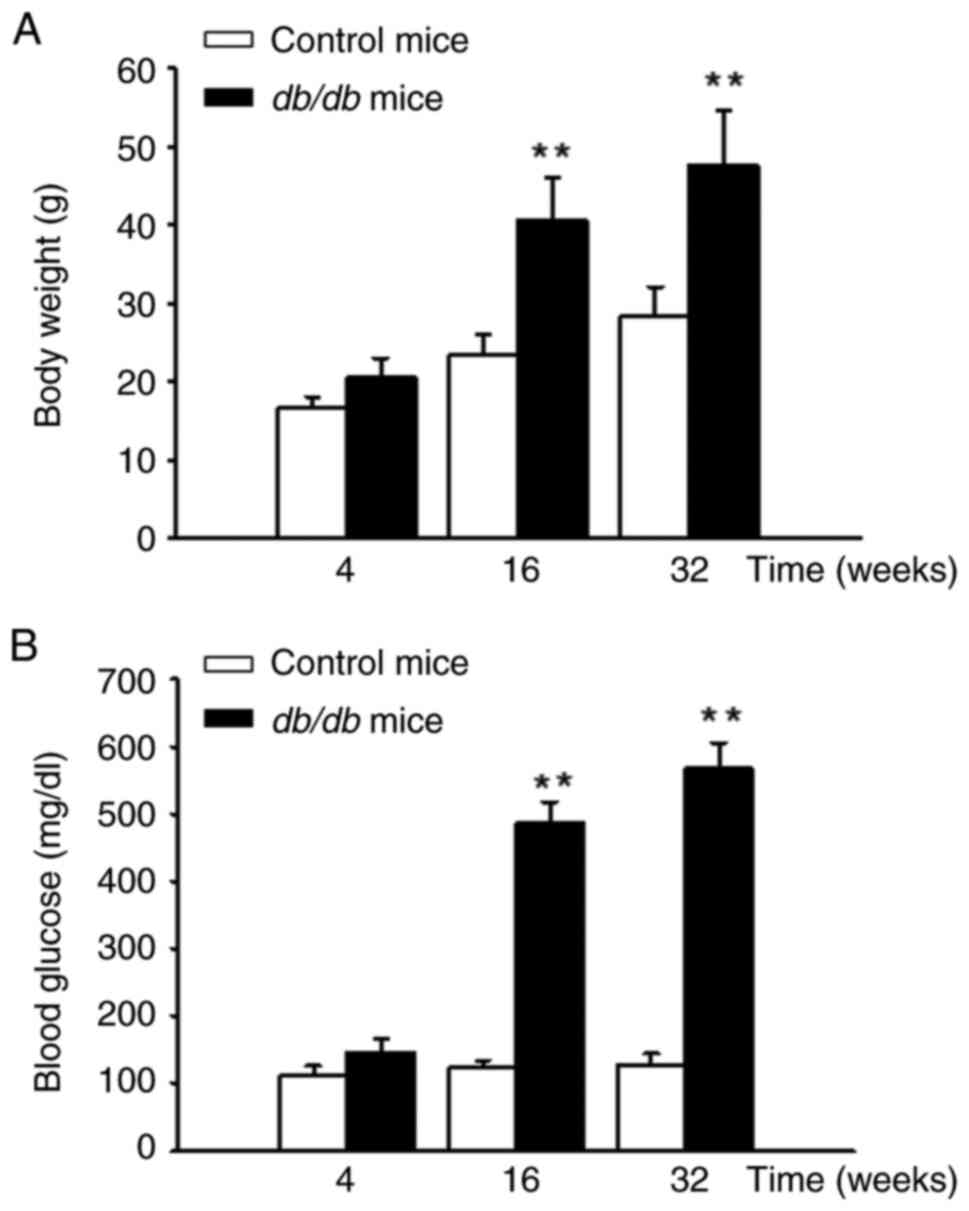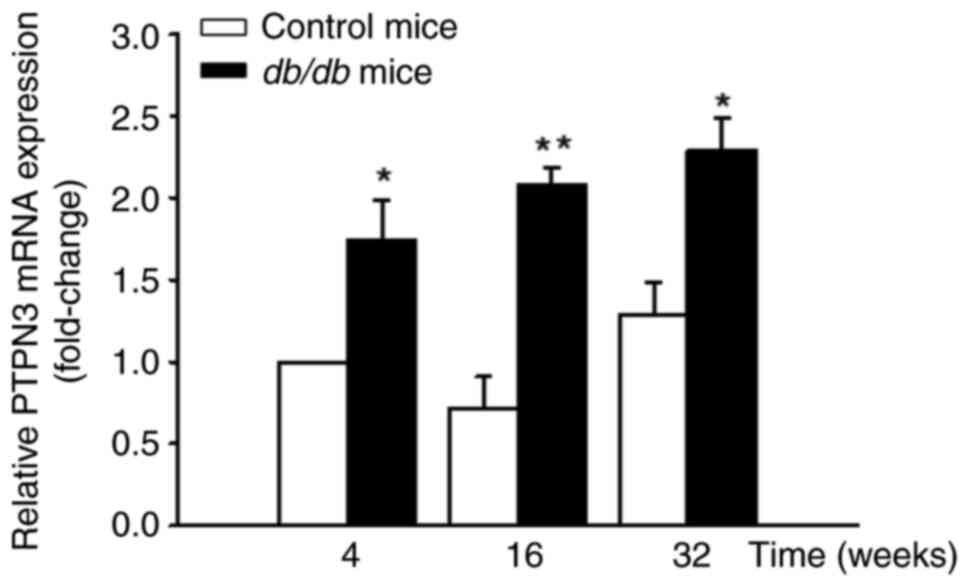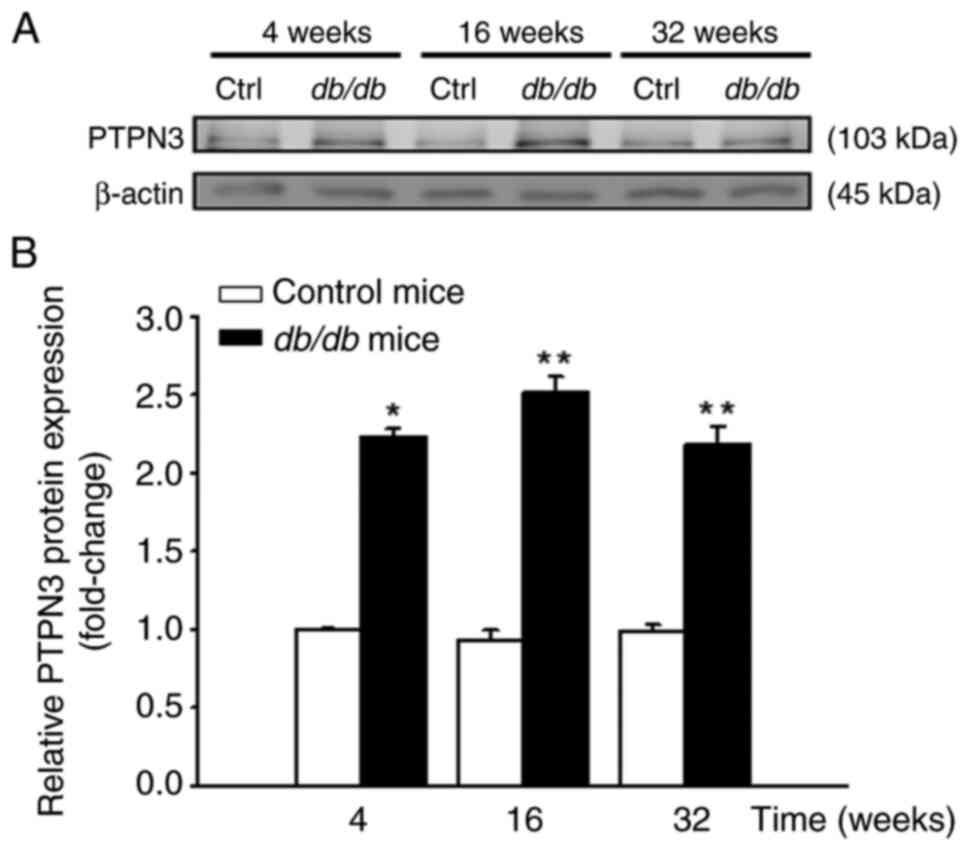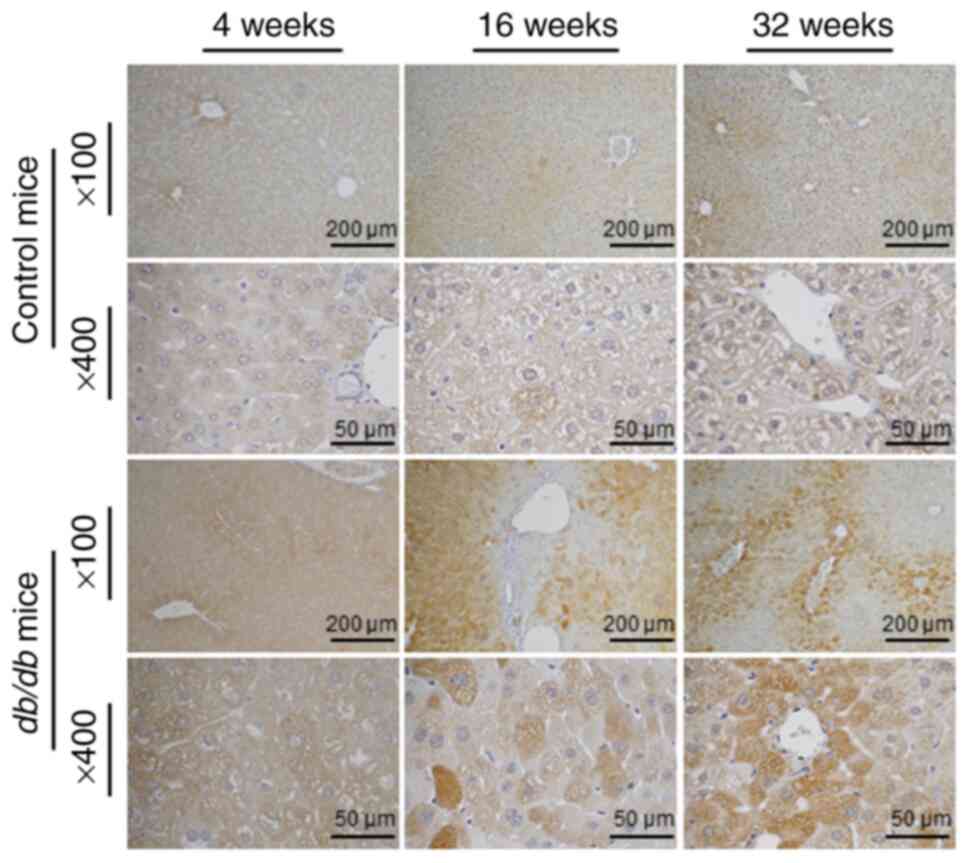Elevated PTPN3 expression in type 2 diabetes mellitus: Insights from genetic and experimental analyses
- Authors:
- Published online on: January 27, 2025 https://doi.org/10.3892/br.2025.1931
- Article Number: 53
Abstract
Introduction
Type 2 diabetes mellitus (T2DM) is characterized by sustained insulin resistance, increased insulin levels and chronic hyperglycemia. It affects 7.7% of adults in developed countries, with prevalence projected to increase by 20% in developed and 70% in developing countries by 2030, highlighting its status as a growing global health concern (1). Prolonged hyperglycemia causes severe damage to essential organs, increasing the risk of cardiovascular disease and diabetic microvascular complications, including atherosclerosis, diabetic nephropathy, retinopathy and neuropathy (1,2). Furthermore, hyperglycemia is a key factor linking T2DM with various types of cancer (3), including pancreatic, liver, breast, endometrial and colorectal cancer (4), as hyperglycemia has been demonstrated to promote the proliferation of cancer cells, resistance to cell death, and cancer cell migration and invasion (3). The development of T2DM is influenced by risk factors, including aging, diet, lifestyle changes and genetics. In 2007, Sladek et al (5) published the first genome-wide association study in the field of T2DM genetics, and identified at least 75 independent genetic loci associated with the disease; however, to date, there has been little focus on investigating genetic factors that may associate T2DM with cancer (6).
The protein tyrosine phosphatase non-receptor type 3 (PTPN3) is a non-transmembrane protein tyrosine phosphatase that serves a role in regulating the membrane cytoskeleton and signal transduction through the T cell antigen receptor (TCR). It is involved in the dephosphorylation of the TCR ζ subunit and the activation of nuclear factor-κB in T cells (7,8). A previous study showed that PTPN3 influences growth hormone receptor expression and systemic growth in mice by regulating insulin-like growth factor 1 secretion (9). Notably, abnormalities in PTPN3 expression are associated with the development and progression of numerous types of human cancer. For example, an increased level of PTPN3 expression was significantly associated with the differentiation and malignancy of human gastric adenocarcinoma (10). Furthermore, Gao et al (11) reported that activating mutations in PTPN3 gene increase proliferation and migration in cholangiocarcinoma cells, also noting an accelerated tumor recurrence in patients with intrahepatic cholangiocarcinoma. In a study that compared global gene transcript profiles between insulin-resistant and -sensitive non-diabetic individuals, Elbein et al (12) found that mRNA expression of PTPN3 was lower in insulin-resistant individuals compared with insulin-sensitive counterparts based on subcutaneous adipose tissue and muscle biopsy sample analyses. Furthermore, a significant increase in PTPN3 gene expression was observed in adipose tissues of patients with acromegaly, who exhibited higher levels of fasting plasma glucose and fasting insulin, and also a higher homeostasis model assessment-insulin resistance (HOMA-IR) index (13). Therefore, the present study aimed to investigate whether variations in PTPN3 genetic polymorphisms may serve a crucial role in the development of T2DM.
In the present study, PTPN3 genetic polymorphisms were examined in blood samples to identify significant differences between patients with T2DM and healthy control subjects. The BKS.Cg-Dock7m+/+ Leprdb/JNarl (db/db) mouse model has been widely used in diabetes research on the basis of the similarity of its pathological progression to that of T2DM (14,15). db/db mice harbor a spontaneous mutation in the leptin receptor gene (Lepr), which results in leptin resistance (16). Lepr genetic defect leads to inability to properly regulate energy balance, contributing to development of obesity, which is a major risk factor for T2DM in humans (17). By 4-6 weeks of age, db/db mice exhibit significant hyperphagia, obesity, hyperglycemia and hyperinsulinemia (18). Furthermore, db/db mice demonstrate diabetes-associated complications such as diabetic nephropathy, hepatic steatosis and cardiovascular disease, which are key for understanding the systemic impacts of T2DM (19). The comprehensive manifestation of T2DM-associated phenotypes makes db/db mice a robust preclinical model to investigate mechanisms underlying T2DM. Therefore, hepatic mRNA and protein levels of PTPN3 were assessed in both db/db and genotype control mice at 4, 16 and 32 weeks of age to analyze association between PTPN3 expression and the progression of T2DM.
Materials and methods
Genotype analysis
A total of 469 patients diagnosed with T2DM (age, 40.5-84.0 years; male:female=51.3: 48.7) was enrolled for DNA genotype analysis through whole blood collection at China Medical University Hospital in Taichung, Taiwan, between August 2014 and July 2015. Patients with T2DM were selected according to the guidelines of the American Diabetes Association, as described previously (20). Briefly, diagnosis of diabetes was based on hemoglobin A1c ≥6.5% or fasting plasma glucose ≥126 mg/dl (7 mmol/l). Fasting was defined as no caloric intake for at least 8 h or 2-h plasma glucose ≥200 mg/dl (11.1 mmol/l) in the oral glucose tolerance test or a patient with classic symptoms of hyperglycemia or hyperglycemic crisis [random plasma glucose ≥200 mg/dl (11.1 mmol/l)]. Exclusion criteria were patients diagnosed with T1DM, maturity-onset diabetes of the young, or gestational diabetes. Genotype frequency data from 1,699 healthy controls were obtained from the Taiwan Biobank (taiwanview.twbiobank.org.tw). The single-nucleotide polymorphisms (SNPs) within the PTPN3 gene were identified using the National Center for Biotechnology Information SNP database (ncbi.nlm.nih.gov/snp). SNPs were selected using Tagger function (software.broadinstitute.org/mpg/tagger/server.html; accessed on 13 Jun 2017) with the additional criteria: i) Threshold minor allele frequency in the HapMap phase 3 and ii) Han Chinese in Beijing, China + Japanese in Tokyo, Japan population of 0.05 for ‘tag SNPs’. All the patients signed informed consent forms, and the study protocol was reviewed and approved by Ethics Committee/Institutional Review Board of China Medical University Hospital (approval no. CMUH103-REC2-071).
Animal studies
A total of 24 male db/db mice (weighing 18-20 g (n=12) and +Dock7m/+Dock7m genotype control counterparts (n=12), all aged 4 weeks, were purchased from the National Laboratory Animal Center in Taipei, Taiwan. The animals were maintained in a temperature-controlled environment at 22±2˚C with 55±10% humidity, a 12/12-h light/dark cycle and had free access to a standard diet and water. As outlined in our previous study (21), db/db mice at the ages of 4, 16 and 32 weeks correspond to early, middle and late stages of T2DM, respectively. Mice were separated into six groups, representing three stages of T2DM (early, middle and late) for both the control and T2DM groups (n=4 mice/group). Blood samples for glucose measurement were obtained with a volume of 10 µl/mouse from the tail veins of the mice at the 4th, 16th and 32nd weeks after a 12-h fasting period. Blood glucose levels were measured using a glucose monitor (ONETOUCH® Ultra Plus Flex™ Meter; ONETOUCH, Inc.). At the end of the procedure, the mice were euthanized via a gradual introduction of CO2 starting at 30% of the chamber volume/min and increasing to 70% of the chamber volume/min, until mice were fully unconscious. To confirm death, cervical dislocation was performed after ensuring that the mice no longer responded to painful stimuli. Liver tissue was collected for further analysis. This animal study was approved by the Institutional Animal Care and Use Committee of China Medical University (approval no. 104-34-C-1).
Reverse transcription-quantitative (RT-q)PCR assay
Total RNA was isolated from liver tissues using RNeasy® mini kit (Qiagen GmbH). cDNA synthesis was performed using a RevertAid™ First Strand cDNA Synthesis kit (Thermo Fisher Scientific, Inc.) following the manufacturer's instructions. cDNA was subjected to RT-qPCR analysis using an ABI ViiA™ 7 RT-PCR system (Thermo Fisher Scientific Inc.) with TaqMan® fluorophore-based probes (Thermo Fisher Scientific, Inc.) and universal probe #1 (cat. no. 04684974001; Roche Diagnostics). The primer sequences for PTPN3 (NM_011207.2) were as follows: forward, 5'-GAATGTTCTCTCTCAGTACTGGACTC-3' and reverse, 5'-CCTTTTTGCAATATTGGTTATTTACA-3'. GAPDH (M32599.1) served as the internal control, with probe #29 (cat. no. 04687612001). The GAPDH primer sequences were as follows: forward, 5'-GAGCCAAACGGGTCATCA-3' and reverse strand, 5'-CATATTTCTCGTGTTCACACC-3'. Thermocycling conditions were as follows: Initial denaturation at 95˚C for 5 min, followed by 25 cycles of 95˚C for 10 sec, 56˚C for 10 sec and 72˚C for 20 sec, and final extension at 72˚C for 5 min. The PCR data for PTPN3 were normalized to the GAPDH threshold cycle value and quantified using the comparative threshold cycle 2-ΔΔCq method (22).
Western blot analysis
Frozen liver tissue (150 mg) was homogenized in 3 ml ice-cold 10 mM phosphate lysis buffer containing 0.25 M sucrose (pH 7.0), 1 mM EDTA, 0.1 mM PMSF and 1 mM sodium azide. The homogenate was centrifuged at 20,000 x g for 30 min at 4˚C. The protein concentration was determined using BCA assay. Subsequently, 40 µg/lane protein was separated by 8% SDS-PAGE and transferred to PVDF membranes. The PVDF membranes were incubated in 5% non-fat dry milk dissolved in Tris-buffered saline containing 0.1% TBS-T) at room temperature for 1 h to block non-specific binding. The membranes were incubated overnight at 4˚C with primary antibodies against PTPN3 (1:1,000; cat. no. GTX54572; GeneTex, Inc.) and secondary antibodies (1:5,000; cat. nos. #31430 and #31460; Thermo Fisher Scientific, Inc.) at room temperature for 1 h. The signals were visualized using an Enhanced Chemiluminescence kit (GE Healthcare) following the manufacturer's protocol, analyzed with ImageQuant 5.2 software (GE Healthcare), and normalized using β-actin (1:5,000; cat. no. ab8226; Abcam) as the internal control.
Immunohistochemistry (IHC) staining analysis
Liver IHC staining was performed using a Leica Bond MAX automated immunostainer (Leica Microsystems, Inc.) as previously described (21). Briefly, tissue sections were dewaxed and treated with 3% H2O2 at room temperature for 10 min for blocking, followed by overnight incubation at 4˚C with a specific rabbit anti-human PTPN3 antibody (1:100; cat. no. GTX54572; GeneTex, Inc.). The sections were treated with a goat anti-rabbit HRP polymer (1:500; cat. no. #31460; Thermo Fisher Scientific, Inc.) for 30 min at room temperature. Chromogen visualization was achieved using DAB for 5 min, and the staining was observed under a light microscope (Leica DM 1000 LED Lab microscope; cat. no. 10052-384; Leica Microsystems, Inc.) at 100x and 400x magnifications.
Statistical analysis
Genotype and allele frequencies of the PTPN3 SNPs rs75235286 and rs17202062 between patients with T2DM and healthy controls were assessed using χ2 test. Additionally, 95% confidence intervals for the odds ratios were calculated for the genotype and allele frequencies of PTPN3 SNPs rs75235286 and rs17202062. Data are presented as the mean ± SD of three independent experimental repeats. Differences were evaluated using one-way ANOVA followed by post hoc least significant difference test. Statistical analyses were performed using IBM SPSS Statistics 27.0 (IBM Corp.). P<0.05 was considered to indicate a statistically significant difference.
Results
Higher allelic frequency of PTPN3 SNPs rs75235286 and rs17202062 in patients with T2DM
A comparative analysis between SNPs in the PTPN3 gene of patients with T2DM and healthy control subjects revealed allele C at the rs75235286 site, and allele G at the rs17202062 site, within the chromosome region 9q31.3 of the PTPN3 gene (Fig. 1). Variants rs75235286 and rs17202062 were identified within chromosome region 9q31.1-9q31.3 in the PTPN3 gene (Fig. 1). Allele C frequency in the rs75235286 SNP of PTPN3 was significantly higher among patients with T2DM (82.1%; 770/938) compared with healthy controls (79.1%; 2688/3398; Table I). Similarly, the allele G frequency in rs17202062 SNP of PTPN3 among patients with T2DM (82.8%; 775/936) was significantly higher compared with that in healthy controls (79.5%; 2,698/3,392). However, the genotype frequencies for rs75235286 and rs17202062 SNP did not exhibit significant differences between the T2DM and healthy control groups.
Table IGenotypic and allelic frequencies of PTPN3 genetic polymorphisms in patients with T2DM and healthy controls. |
Significant increases in body weight and blood glucose levels in db/db mice compared to controls mice
The db/db mice exhibited a significant increase in body weight compared with the control group (Fig. 2A) at 16 and 32 weeks. Additionally, blood glucose levels in the db/db mice were significantly elevated from the 4th to the 32nd week. By the 32nd week, the blood glucose levels in db/db mice were >500 mg/dl (Fig. 2B).
Elevated hepatic PTPN3 mRNA and protein expression in db/db mice
Hepatic mRNA levels of PTPN3 were significantly higher in db/db mice compared with the control mice (Fig. 3). Similarly, PTPN3 protein levels were significantly higher in liver tissues of db/db compared with control mice (Fig. 4). IHC staining data demonstrated a marked increase in hepatic PTPN3 expression in db/db mice compared to control mice. This increase was consistently observed across all evaluated time points, with clear localization of PTPN3 staining predominantly in hepatocytes. The intensity and extent of PTPN3 staining were visibly greater in db/db mice, indicating an upregulation of the protein in response to the diabetic condition. The most pronounced difference was observed at 32 weeks; db/db mice showed strong, widespread PTPN3 staining, whereas control mice exhibited minimal staining levels (Fig. 5).
Discussion
T2DM is a multifaceted metabolic disorder with a notable genetic predisposition; understanding the role of epigenetic modifications is key in T2DM research. Additionally, there is a well-established connection between T2DM and development of cancer (23,24). Given the frequent occurrence of cancer in individuals with diabetes, it is essential to investigate the potential factors that connect these diseases. Several contributing elements, such as poor glycemic control, dyslipidemia and elevated levels of insulin-like growth factors, influence both T2DM and cancer development (4). Additionally, these factors adversely impact the effectiveness of cancer treatment. In the present study, patients with T2DM and db/db mice, a widely used T2DM animal model (14,15,25), exhibited increased levels of PTPN3 gene expression. As the PTPN3 gene is associated with a higher incidence of different types of cancer (10,11), an elevated expression of PTPN3 in T2DM may represent another crucial pathological connection between T2DM and cancer. To the best of our knowledge, the present study is the first to support this.
PTPN3 gene encodes the PTPN3 protein, which is an enzyme that is involved in cellular signaling pathways that regulate various processes, including cell proliferation, differentiation, mitosis, and potentially, oncogenic transformation (26). Hochberg et al (13) suggested that patients with acromegaly with higher PTPN3 expression in adipose tissues exhibit elevated fasting plasma glucose levels and fasting insulin levels and higher HOMA-IR scores compared with patients with non-functioning pituitary adenoma. PTPN3 is associated with growth hormone signaling and may perform a role in glucose homeostasis (9,27). Therefore, its upregulation may affect pathological development of T2DM. Additionally, this enzyme is involved in regulation of the plasma membrane cytoskeleton, TCR-associated signal transduction and T cell activation (7,8). A recent study has reported on the critical role of PTPN3 in modulating immune responses in cancer, especially via influencing the production of cytokines such as IL-6 and tumor necrosis factor-α (TNF-α) (28). Additionally, poorly regulated glucose metabolism and hyperglycemia in diabetic patients are often associated with higher levels of chronic inflammatory markers, including IL-1β, IL-6 and TNF-α (29-31). Immune response activation contributes to the development and progression of cancer cells (32). Based on the aforementioned findings, it was hypothesized that an increased expression of PTPN3 in patients with T2DM may lead to an imbalance in the immune system. This imbalance may disrupt regulation of both inflammatory and anti-inflammatory responses, potentially accelerating progression of T2DM. The present results do not align with the findings of Elbein et al (12), which indicated that PTPN3 expression is downregulated in both adipose and muscle tissues of insulin-resistant individuals, highlighting its potential role in insulin resistance and metabolic regulation pathways, it is important to consider that the therapeutic approach for patients with T2DM with elevated PTPN3 expression may require some adjustment. Further studies, including animal and clinical studies, are key to explore the effects of increased PTPN3 expression on pathological progression of T2DM.
Yin et al (33) demonstrated that p38γ promotes dephosphorylation of epidermal growth factor receptor via activating PTPN3 and silencing the p38γ/c-Jun/PTPN3 signaling pathway increases sensitivity of K-Ras mutant cells to tyrosine kinase inhibitors. Similarly, Gao et al (11) found that patients with intrahepatic cholangiocarcinoma with higher PTPN3 protein levels have increased recurrence rates of cancer. These findings suggested that PTPN3 requires co-factors such as p38γ to mediate its oncogenic effects. Furthermore, PTPN3 expression is markedly increased in cisplatin- and doxorubicin-resistant ovarian cancer cells and silencing PTPN3 restored drug-sensitivity and inhibited cancer cell migration, stemness and tumorigenicity (34). Individuals with T2DM are at heightened risk for various types of cancers and encounter additional challenges due to elevated PTPN3 levels, which are exacerbated by p38γ-induced phosphorylation. This not only increases cancer risk but also promotes drug resistance, complicating treatment. Strategies targeting PTPN3 or its phosphorylation pathway must address both diabetes and related oncogenic risks, while balancing effectiveness and safety. Therefore, medical strategies that focus on decreasing PTPN3 expression or p38γ-induced phosphorylation of PTPN3 could be beneficial for patients with T2DM with high PTPN3 levels. These approaches may decrease cancer incidence and improve drug resistance in this population. The present study primarily focused on the significant increase in PTPN3 expression in diabetic patients and db/db mice and the mechanistic role of PTPN3 in cancer development was not directly examined herein. However, previous studies support the involvement of PTPN3 in oncogenesis: PTPN3 mutations could promote tumor proliferation and migration in cholangiocarcinoma (11) and Wu et al (10) demonstrated that PTPN3 overexpression is associated with malignancy in gastric adenocarcinoma and with drug resistance in various types of cancer cell. Future studies should explore the functional role of PTPN3 in cancer development in patients with T2DM, including the effect on tumor growth and cancer-associated signaling pathways in diabetic models with elevated PTPN3 expression.
A limitation of the present study is the absence of comprehensive clinicopathological data for T2DM patients involved. This lack of information could introduce biases in interpreting the association between PTPN3 expression and the progression of T2DM. However, to reduce these potential biases, the study was designed with strict inclusion criteria, focusing solely on genetic polymorphism analysis and using a well-defined control group from the Taiwan Biobank. For future research, it is essential to include clinicopathological data such as age, BMI, disease stage and duration to clarify the role of PTPN3 in T2DM pathology and its potential association with cancer risk. Additionally, future studies should incorporate western blot analysis to measure PTPN3 levels in serum proteins from patients with T2DM and healthy controls to confirm the results obtained from the db/db mouse model and establish the association between PTPN3 expression and clinical outcomes. Furthermore, examining the expression of PTPN3 in additional tissue samples, such as adipose and muscle tissues, may reveal its broader impact on systemic effects of T2DM, demonstrating the association between T2DM, PTPN3 expression and cancer, potentially guiding therapeutic developments.
In conclusion, in the present study, expression of PTPN3 gene and protein was significantly elevated in patients with T2DM and db/db mice. Upregulated PTPN3 may contribute to progression of diabetic complications, cancer and drug resistance in patients with T2DM due to its interactions with other molecules, such as p38γ. The present findings suggest that the role of PTPN3 gene warrants further investigation.
Acknowledgements
Not applicable.
Funding
Funding: The present study was supported by Chung Shan Medical University, Taichung, Taiwan (grant no. RD11211) and China Medical University (grant no. CMU110-N-30).
Availability of data and materials
The data generated in the present study may be requested from the corresponding author.
Authors' contributions
SYC, RYT and CCC performed the experiments and wrote the manuscript. SYC and CCC confirm the authenticity of all raw data. TJT analyzed data and constructed the figures. SYC and CCC conceived the study. All authors have read and approved the final manuscript.
Ethics approval and consent to participate
The present study was approved by Ethics Committee/Institutional Review Board of China Medical University Hospital (approval no. CMUH103-REC2-071). Additionally, the animal study was approved by the Institutional Animal Care and Use Committee of China Medical University (approval no. 104 34 C 1).
Patient consent for publication
Not applicable.
Competing interests
The authors declare that they have no competing interests.
Use of artificial intelligence tools
During the preparation of this work, AI tools were used to improve the readability and language of the manuscript or to generate images, and subsequently, the authors revised and edited the content produced by the AI tools as necessary, taking full responsibility for the ultimate content of the present manuscript.
References
|
Gray SP and Jandeleit-Dahm K: The pathobiology of diabetic vascular complications-cardiovascular and kidney disease. J Mol Med (Berl). 92:441–452. 2018.PubMed/NCBI View Article : Google Scholar | |
|
Faselis C, Katsimardou A, Imprialos K, Deligkaris P, Kallistratos M and Dimitriadis K: Microvascular complications of type 2 diabetes mellitus. Curr Vasc Pharmacol. 18:117–124. 2020.PubMed/NCBI View Article : Google Scholar | |
|
Ryu TY, Park J and Scherer PE: Hyperglycemia as a risk factor for cancer progression. Diabetes Metab J. 38:330–336. 2014.PubMed/NCBI View Article : Google Scholar | |
|
Wojciechowska J, Krajewski W, Bolanowski M, Kręcicki T and Zatoński T: Diabetes and cancer: A review of current knowledge. Exp Clin Endocrinol Diabetes. 124:263–275. 2016.PubMed/NCBI View Article : Google Scholar | |
|
Sladek R, Rocheleau G, Rung J, Dina C, Shen L, Serre D, Boutin P, Vincent D, Belisle A, Hadjadj S, et al: A genome-wide association study identifies novel risk loci for type 2 diabetes. Nature. 445:881–885. 2007.PubMed/NCBI View Article : Google Scholar | |
|
Vincent EE and Yaghootkar H: Using genetics to decipher the link between type 2 diabetes and cancer: Shared aetiology or downstream consequence? Diabetologia. 63:1706–1717. 2020.PubMed/NCBI View Article : Google Scholar | |
|
Han S, Williams S and Mustelin T: Cytoskeletal protein tyrosine phosphatase PTPH1 reduces T cell antigen receptor signaling. Eur J Immunol. 30:1318–1325. 2000.PubMed/NCBI View Article : Google Scholar | |
|
Young JA, Becker AM, Medeiros JJ, Shapiro VS, Wang A, Farrar JD, Quill TA, van Huijsduijnen RH and van Oers NSC: The protein tyrosine phosphatase PTPN4/PTP-MEG1, an enzyme capable of dephosphorylating the TCR ITAMs and regulating NF-kappaB, is dispensable for T cell development and/or T cell effector functions. Mol Immunol. 45:3756–3766. 2008.PubMed/NCBI View Article : Google Scholar | |
|
Pilecka I, Patrignani C, Pescini R, Curchod ML, Perrin D, Xue Y, Yasenchak J, Clark A, Magnone MC, Zaratin P, et al: Protein-tyrosine phosphatase H1 controls growth hormone receptor signaling and systemic growth. J Biol Chem. 282:35405–35415. 2007.PubMed/NCBI View Article : Google Scholar | |
|
Wu CW, Chen JH, Kao HL, Li AFY, Lai CH, Chi C and Lin WC: PTPN3 and PTPN4 tyrosine phosphatase expression in human gastric adenocarcinoma. Anticancer Res. 26:1643–1649. 2006.PubMed/NCBI | |
|
Gao Q, Zhao YJ, Wang XY, Guo WJ, Gao S, Wei L, Shi JY, Shi GM, Wang ZC, Zhang YN, et al: Activating mutations in PTPN3 promote cholangiocarcinoma cell proliferation and migration and are associated with tumor recurrence in patients. Gastroenterology. 146:1397–1407. 2014.PubMed/NCBI View Article : Google Scholar | |
|
Elbein SC, Kern PA, Rasouli N, Yao-Borengasser A, Sharma NK and Das SK: Global gene expression profiles of subcutaneous adipose and muscle from glucose-tolerant, insulin-sensitive, and insulin-resistant individuals matched for BMI. Diabetes. 60:1019–1029. 2011.PubMed/NCBI View Article : Google Scholar | |
|
Hochberg I, Tran QT, Barkan AL, Saltiel AR, Chandler WF and Bridges D: Gene expression signature in adipose tissue of acromegaly patients. PLoS One. 10(e0129359)2015.PubMed/NCBI View Article : Google Scholar | |
|
Ohno T, Shimizu M, Shirakami Y, Baba A, Kochi T, Kubota M, Tsurumi H, Tanaka T and Moriwaki H: Metformin suppresses diethylnitrosamine-induced liver tumorigenesis in obese and diabetic C57BL/KsJ-+Leprdb/+Leprdb mice. PLoS One. 10(e0124081)2015.PubMed/NCBI View Article : Google Scholar | |
|
Guest PC and Rahmoune H: Characterization of the db/db mouse model of type 2 diabetes. Methods Mol Biol. 1916:195–201. 2019.PubMed/NCBI View Article : Google Scholar | |
|
Chen H, Charlat O and Tartaglia LA: Genetics of leptin and obesity: db/db mice as a model for human obesity. Nat Rev Genet. 13:145–155. 2012. | |
|
Chua SC, White DW and Wu-Peng XS: Phenotype of fatty liver and diabetes in leptin receptor-deficient db/db mice. J Clin Invest. 97:1258–1264. 1996. | |
|
King AJ: The use of animal models in diabetes research. Br J Pharmacol. 166:877–894. 2012.PubMed/NCBI View Article : Google Scholar | |
|
Sharma K and Ziyadeh FN: Hyperglycemia and diabetic complications: The role of TGF-β in the pathogenesis of diabetic nephropathy. Kidney Int. 48 (Suppl 52):S7–S10. 1995. | |
|
American Diabetes Association. Diagnosis and classification of diabetes mellitus. Diabetes Care. 33 (Suppl 1):S62–S69. 2010.PubMed/NCBI View Article : Google Scholar | |
|
Tang YH, Wang YH, Chen CC, Chan CJ, Tsai FJ and Chen SY: Genetic and functional effects of adiponectin in type 2 diabetes mellitus development. Int J Mol Sci. 23(13544)2022.PubMed/NCBI View Article : Google Scholar | |
|
Huang TH, Chen CC, Liu HM, Lee TZ and Shieh SH: Resveratrol pretreatment attenuates concanavalin A-induced hepatitis through reverse of aberration in the immune response and regenerative capacity in aged mice. Sci Rep. 7(2705)2017.PubMed/NCBI View Article : Google Scholar | |
|
Giovannucci E, Harlan DM, Archer MC, Bergenstal RM, Gapstur SM, Habel LA, Pollak M, Regensteiner JG and Yee D: Diabetes and cancer: A consensus report. CA Cancer J Clin. 60:207–221. 2010.PubMed/NCBI View Article : Google Scholar | |
|
Bonagiri PR and Shubrook JH: Review of associations between type 2 diabetes and cancer. Clin Diabetes. 38:256–265. 2020.PubMed/NCBI View Article : Google Scholar | |
|
Bogdanov P, Corraliza L, Villena JA, Carvalho AR, Garcia-Arumí J, Ramos D, Ruberte J, Simó R and Hernández C: The db/db mouse: A useful model for the study of diabetic retinal neurodegeneration. PLoS One. 9(e97302)2014.PubMed/NCBI View Article : Google Scholar | |
|
Tonks NK and Neel BG: Combinatorial control of the specificity of protein tyrosine phosphatases. Curr Opin Cell Biol. 13:182–195. 2001.PubMed/NCBI View Article : Google Scholar | |
|
Nishad R, Mukhi D, Menon RK and Pasupulati AK: Growth hormone and metabolic homeostasis. EMJ Diabet. 6:78–87. 2018. | |
|
Iwamoto N, Onishi H, Masuda S, Imaizumi A, Sakanashi K, Morisaki S, Nagao S, Koga S, Ozono K, Umebayashi M, et al: PTPN3 inhibition contributes to the activation of the dendritic cell function to be a promising new immunotherapy target. J Cancer Res Clin Oncol. 149:14619–14630. 2023.PubMed/NCBI View Article : Google Scholar | |
|
Stentz FB, Umpierrez GE, Cuervo R and Kitabchi AE: Proinflammatory cytokines, markers of cardiovascular risks, oxidative stress, and lipid peroxidation in patients with hyperglycemic crises. Diabetes. 53:2079–2086. 2004.PubMed/NCBI View Article : Google Scholar | |
|
Lee H, Kim MJ, Lee IK, Hong CW and Jeon JH: Impact of hyperglycemia on immune cell function: A comprehensive review. Diabetol Int. 15:745–760. 2024.PubMed/NCBI View Article : Google Scholar | |
|
Pickup JC: Inflammation and activated innate immunity in the pathogenesis of type 2 diabetes. Diabetes Care. 27:813–823. 2004.PubMed/NCBI View Article : Google Scholar | |
|
Chang SC and Yang WCV: Hyperglycemia, tumorigenesis, and chronic inflammation. Crit Rev Oncol Hematol. 108:146–153. 2016.PubMed/NCBI View Article : Google Scholar | |
|
Yin N, Lepp A, Ji Y, Mortensen M, Hou S, Qi XM, Myers CR and Chen G: The K-Ras effector p38γ MAPK confers intrinsic resistance to tyrosine kinase inhibitors by stimulating EGFR transcription and EGFR dephosphorylation. J Biol Chem. 292:15070–15079. 2017.PubMed/NCBI View Article : Google Scholar | |
|
Zhou Z, Lin Z, Wang M, Wang L, Ji Y, Yang J, Yang Y, Zhu G and Liu T: Identification and verification of PTPN3 as a novel biomarker in predicting cancer prognosis, immunity, and immunotherapeutic efficacy. Eur J Med Res. 29(12)2024.PubMed/NCBI View Article : Google Scholar |



